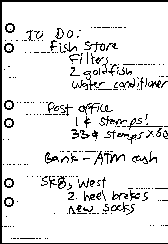Technique
At the conclusion of my in-line clinics, I am frequently asked, "So after I master these skills, what's next for me as a skater?" Beginner or intermediate, I always advise people to skate as often and long as possible. Quality hours on skates is the best way to improve balance and coordination enough to progress from the beginner's basics through an intermediate's competence to the thrilling activities practiced by advanced skaters today. The advanced skater is immediately recognizable in the world of the wheeled:

These skaters have extended their joy of skating to an in-line lifestyle, adapting the sport's convenience, health and social benefits into their daily lives. Beyond the turning, striding, speed control and stopping skills of the competent skater, their movements illustrate the advanced skater's sense of balance, elegant coordination, and physical confidence. What secret element transforms competent skaters to advanced? Nothing more than a goal and more hours on a roll. Advanced skaters have all acted on a desire to:
- She's the girl in a tuck who effortlessly passes cyclists on the bike path, her long, graceful strokes belying the power that makes her go fast.
- He's the fit-looking man whose dancing frames glint in the sunlight as he spins, moonwalks and prances to a boom box, never stumbling or missing the beat.
- She's the determined kid down the street who endlessly kicks a soccer ball all over the neighborhood--on skates.
- He's the fellow with a daypack often seen downtown, rolling out of the Post Office or the drug store or up to the entrance of an office building.
Approximately 90% of the world's in-line skaters fall into the class of recreational participants at the beginner and intermediate levels. With the desire and focused time on skates, all are advanced-skater candidates capable of participating in any of the activities listed above.
- explore new places, even if it meant skating on rough pavement or close to traffic.
- teach others how to stride, turn and stop safely.
- compete in team sports on wheels: roller hockey, roller soccer, or roller basket ball.
- combine the joys of movement and physical expression through dance.
- increase public awareness for a worthy cause by participating in endurance or speedskating events.
- increase the intensity and effectiveness of their in-line workouts.
- cross-train on skates to improve their performance for skiing, wind surfing, biking, rowing or ice skating.
- preserve air quality by commuting to work or running errands on skates.
- take a guided skate tour of Holland's canals or Pennsylvania's Amish country.
- compete in endurance, speed, downhill, figure, or aggressive competitions.
It's up to you to choose the direction in which you'd most like to grow. The opportunities continue to expand as the sport matures, I've described the most common in-line pursuits below. See which of these fits your style or interests you enough to become an advanced skater.
Aggressive
If you're still nubile and believe in your own immortality, imagine launching off a 5-foot ramp or half pipe to execute aerial stunts, or grinding your wheel frames down curbs, stair railings and tree planters. Besides specialized skates and daring (or a willingness to run from the law), aggressive skating demands precise footwork, excellent balance and more than a little endurance, in every sense of the word.Fitness
Excellent fitness benefits are within reach of recreational skaters who have access to long, uninterrupted trails or routes. Since the fluid in-line stride delivers non-impact cardiovascular, body composition and muscular benefits, in-line workouts are ideal for those who are interested in building and maintaining healthy bodies through sustained physical effort. For mature skaters, in-line skating is one of the best (and certainly most fun!) forms of non-impact aerobic workouts around.Freestyle
Freestyle includes everything from line dancing to the funky beat of a boom box to performance figure skating. In 1997, the first skates specifically designed for off-ice figure skating appeared on the market, complete with leather boots and a rubber toe pick for launching into jumps and spins. This innovation continues to spur growth in the still-young discipline.
Roller Hockey
The excitement generated by team dynamics, stick handling and competitive play quickly improves all striding and maneuvering skills because players have to think on their feet instead of about their feet. The serious non-goalie player needs a hockey stick, protective gloves, a face shield and mouthpiece, hockey pants, shin guards, shoulder pads and, for males, a jock strap and cup. Goalies need even more stuff, so start saving your lunch money now!Skate to Ski
Dry-land training improves slalom skiing technique so dramatically that Olympic and pro skiers use in-line drills in the off-season. Cross-training with ski poles not only develops better, more centered snow skiers, it also helps skaters in both climbing and descending steeper asphalt hills.Speedskating
For competitive souls who love speed or endurance work, racing is the natural next stroke. But be prepared for the expense of lightweight custom boots, precision bearings, five-wheel frames and new or like-new wheels for each event. Many promoters include non-pro events that give amateurs the opportunity to get a taste of the team strategies, training and pace lines that allow pro racers to excel. Downhill speed and indoor track races expand the opportunities for competition.
You've just read my definition of an advanced skater. What qualities do you think characterize an advanced skater? Who are your skating heroes? Why? I'm eager to hear your thoughts, because I am currently planning my third book, an advanced skater's guide. This spring, I'd love to hear what you think skaters should know or do to reach advanced proficiency.
To share your definition, simply email me your comments and include your name (just in case I decide to quote you!).